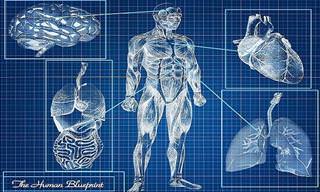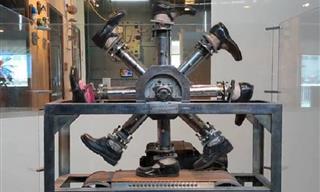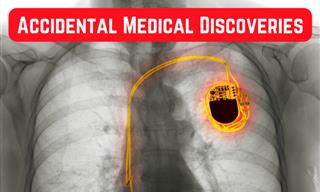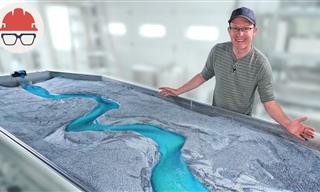
Here's a bit of news you probably weren't expecting to hear today: After more than 100 years of X-rays being flat and monochrome, they may very soon finally take the leap into the 21st Century and start being displayed as full-color 3D models.

Phil and Anthony Butler, father and son scientists from the universities of New Zealand's Canterbury and Otago have created the world's first ever 3D color medical scanner. They named it the MARS spectral X-ray scanner, and it is able to capture internal images of both bone as well as all of its surrounding tissue.
According to Anthony Butler, "X-ray spectral information allows health professionals to measure the different components of body parts such as fat, water, calcium, and disease markers," and that "traditional black-and-white X-rays only allow measurement of the density and shape of an object."
As you can see from the video below, the scanner will also allow doctors to see the inner structure of a target area layer by layer:
Whereas regular X-rays use film or a sensor to record radiation levels, the MARS scanner actually measures the whole X-ray spectrum, and even goes as far as to detect and count the many particles as they collide with the pixels. This means that the MARS scanner works in a similar way to a camera, providing an HD image that is in color and fully 3D.
The technology used in the MARS scanner comes straight from CERN's Large Hadron Collider, which is the biggest and most powerful particle accelerator in the world. In fact, a chip which was designed for particle detection and imaging in the collider, known as Medipix3, was actually adapted by Phil and Anthony Butler's team so that it could be used in the MARS scanner.

According to Phil Butler, "this technology sets the machine apart diagnostically because its small pixels and accurate energy resolution mean that this new imaging tool is able to get images that no other imaging tool can achieve."
While the MARS scanner has been under development for close to ten years, clinical trials have only begun very recently. However, all results so far are showing that the MARS scanner will very likely become one of the medical community's most indispensable tools in the near future.
"So far researchers have been using a small version of the MARS scanner to study cancer, bone, and joint health, and vascular diseases that cause heart attacks and strokes," Butler said. "In all of these studies, promising early results suggest that when spectral imaging is routinely used in clinics it will enable more accurate diagnosis and personalization of treatment."
Don't forget to share this exciting news with your friends and family, too!
Source: mnn
Images: marsbioimaging
Related Articles:
Bone Spurs: What They are and How to Treat Them

Not Only Covid-19: 5 Historically Significant Vaccines
Infectious diseases were a problem long before Covid-19. These are 5 of the most historically important vaccines that made the world safer.
 7:17
7:17
Vaccinations SHOULD Trigger Side Effects, Here’s Why
Once you watch this video and understand why vaccine side effects happen, you may even be happy to get that headache.
 5:14
5:14
Studying Dolphins May Be Key to Advancing Medicine
Scientists have noticed a strange behavior in red sea dolphins, and they believe this is a form of self-medication. Learn why this discovery is so important.

Viagra May Hold the Key to Preventing Colorectal Cancer...
A new study shows that Viagra may be able to help prevent the onset of colorectal cancer. Find out all about it here.
 8:32
8:32
Homeopathy: Real Medicine or Hoax? An Explanation.
Find out exactly what homeopathy is and how it works with this fascinating video.
 5:47
5:47
Shocking! This Is What Chocolate Does to Your Arteries...
Can chocolate cause strokes? Find out in this informative video from Dr. Greger.

These Are the Miracles That Happen in Our Bodies Every Day
There is a lot that happens inside our bodies every single day. Did you know any of these facts?
 3:16
3:16
You Wouldn't Believe How Far Technology Has Come
Take a look at the advancements of technology in this video. Impressive.

10 Fascinating Facts About the Subconscious Mind
10 facts about the way the subconscious mind works

First US Embryo to be 'Edited'; Rise of Genetic Changes!
Could the first human embryos be genetically modified?

Ancient Skull Found In China Unlike Any Human Ever Seen
A newly-discovered skull in China had baffled scientists. This could mean we might have discovered an entirely new species of humans.

14 of the Most Fascinating Specialized Tools You'll See
We bet you haven’t seen these unique tools before!

Wow! Who Knew That Jupiter Was So Mesmerizing?
Take a look at Jupiter like you've never seen it before!
 19:33
19:33
Thought Nature is Wild? See It Under a Microscope
You won't believe the things you could discover by looking at everyday items under a microscope.
 3:16
3:16
Discover How Anesthesia Affects Your Body and Mind
If you were ever curious about how exactly anesthesia works, then this video has all the answers!
 23:26
23:26
Incredible: This Man Got the First Double-Arm Transplant
Felix Gretarsson got burned in both arms and needed the new ones. For that purpose, he went through history's FIRST 2-arm transplant.
 7:27
7:27
Check Out This Radio-Controlled Lego-Powered Submarine
This is the height of creativity! Check out this insanely cool Lego submarine. It actually works!

Guide: All About the Gut-Brain Connection in Your Body
it's becoming increasingly clear just how influential our tiny gut microbes are in shaping our mood and even our overall health.
 14:24
14:24
Are Underwater Turbines the Answer to Our Energy Question?
One of the most promising technologies in the renewable energy market is the ocean. Learn all about it.

These Photos Show How Dependent We are On Smartphones
Technology has taken over and these funny (but true) photos help to drive this fact home.
 3:10
3:10
How It's Made: Merino Wool
Long before we invented moisture-wicking synthetic fibers, this type of wool did it naturally for centuries. Here's how it's produced.

This Map Shows Every Known Nuclear Explosion Since 1945
This series of 3D maps will help you visualize the timeline of every known nuclear explosion conducted since 1945 and until 2019

These Archaeological Finds Left the World Mystified
Find out more about the most mysterious discoveries that archaeologists made.

New Study: There is a Sure Way to Slow Aging
This new study confirms what has long been suspected: The less calories we consume, the slower we age.
 5:13
5:13
Whatever Happened to that Hole in the Ozone Layer?
Let's embark on this enlightening journey to better understand our atmosphere's health.

You Won't Believe That These Things Exist in Japan...
If there's one place on this planet that well and truly at the forefront of modern technology, it has got to be Japan, as these inventions prove...
 5:05
5:05
How Do the Drugs We Take Affect Our Brain?
We take many pills these days. What is it exactly that they DO to our brain? Find out now.

GUIDE: How Alcohol Affects Us, Drink by Drink...
In this article, we're going to discuss the exact amounts of alcohol in our blood and what they look like, including how each level affects us and our ability to function.

There are Some Great Secrets Found in Mathematics...
Numbers hold some great secrets - they even tell us about life!
 4:52
4:52
Are There Universal Expressions of Emotion? Find Out Here!
Do facial expressions look the same and communicate the same meaning wherever you are in the world? Find out here!

Travel From the Sun to Pluto With Our Interactive Guide!
The solar system is a fascinating place, and we wanted to bring you an interactive journey that you can use to travel through it. Enjoy the journey!

How Your Eye Came to Be the Color It Is...
Why do we have different-colored eyes, and what does it mean?
 8:11
8:11
Fascinating: What is the Deepest Hole Humanity Has Dug?
This video explains how low humanity has dug down so far.

6 Fascinating Stories of Accidental Medical Discoveries
From penicillin to pacemakers, here are the medical breakthroughs that were discovered by accident.
 10:01
10:01
9 UNBELIEVABLE Ice Science Tricks That'l Amaze You
Prepare to be amazed as ice takes center stage in these mind-boggling and unconventional science experiments.

The History of Our Planet in One Beautiful Spiral...
This beautiful infographic offers us a remarkable story – the history of Planet Earth.
 17:48
17:48
This Visual Shows the Science Behind the Shape of Rivers
A fascinating visual model that explains why and how rivers change their course.

When Under a Microscope, Even Ordinary Things Seem Alien
Have you ever given any thought to what every day things look like under a microscope? Some of these images are truly beautiful - see for yourself in the images below.
 3:26
3:26
The McGurk Effect - Don't Believe Your Eyes!
What we hear can be affected by what we see...

Chocolate Exposed! Here's What It Does to Your Brain!
Just what is it that makes chocolate so irresistible to so many people around the world? Find all of the answers in the article.

The Facts You Didn't Know About the Human Body...
Discover 120 fascinating and surprising facts about your body you may not have known. Going over most of the body parts, you will learn so much you never knew about the body we all use.
 21:07
21:07
15 Frightening Animals Early Humans Had to Live With
10 scary animals early cavemen in Africa had to deal with 200,000 years ago.

26 Incredible Facts About the Human Mind
The human brain is an interesting and powerful organ, which is why we've gathered 26 interesting facts about exactly how human psychology works.

6 Weird and Creepy Medical Tools of the Past
After seeing these weird and creepy medical devices of the past, you’ll be thankful you live in the 21st century. Take a look for yourself.
 5:13
5:13
What is Your Consciousness? A Remarkable Video...
This video by Ted-ed searches to explain the origin of consciousness as well as what is consciousness.

Scientists Develop 'Flying Dragon' Robot to Fight Fires
Scientists in Japan have created a water-spitting 'flying dragon' robot to fight fires.

Amazing Science: THIS is the True Scale of Our Universe...
Get a sense of the true scale and shape of the universe we've discovered so far.


